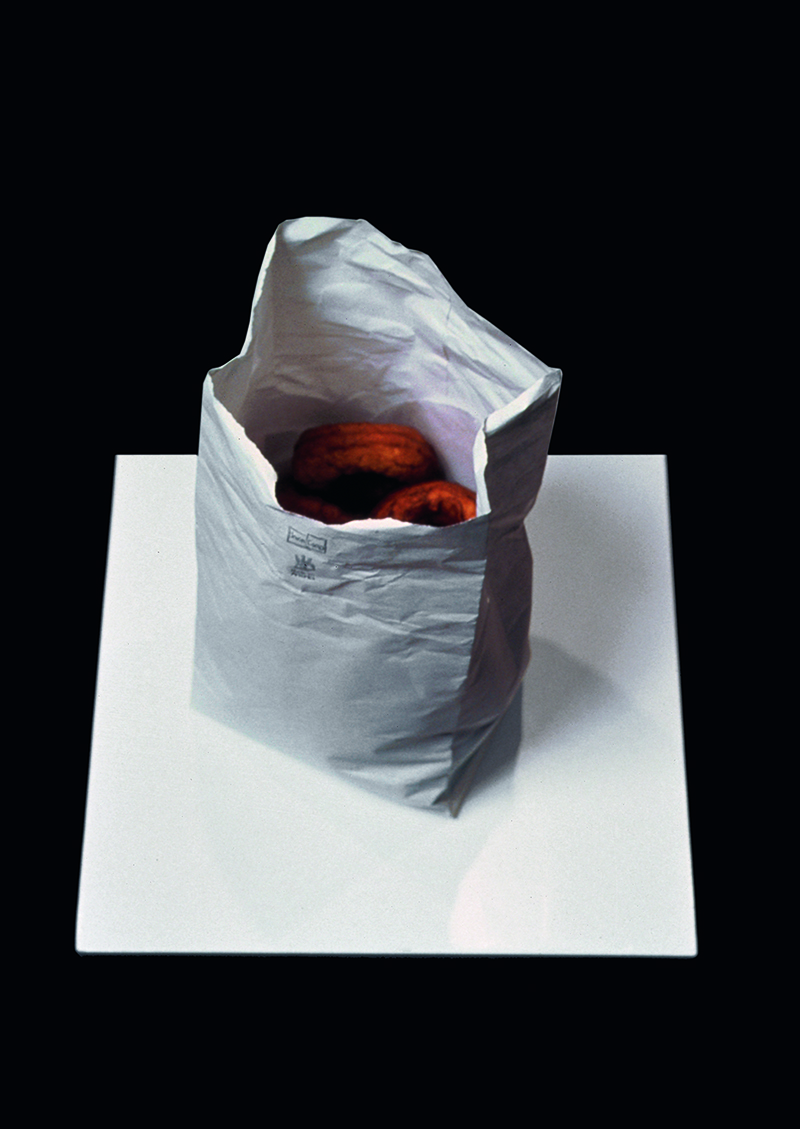
Robert Gober, Bag of Donuts, 1989; acid free hand cut paper, graphite, dough, synthetic resin; edition of 8 with 1 AP; 11 x 6 1/2 x 6 inches. Courtesy the artist and Paula Cooper Gallery, New York. Photo: Geoffrey Clements
In October 1989, a solo exhibition by Robert Gober opened at Paula Cooper Gallery in New York City. The work was arranged in multiple rooms, the walls papered with imagery and objects placed throughout the spaces. In the second room—against Male and Female Genital Wallpaper—sat the sculpture Bag of Donuts, displayed on a pedestal.1 In attendance at the opening was the critic, curator, and artist Ed Brzezinski. As quoted in a New York Post article, Brzezinski related: “I noticed this bag of doughnuts sitting on a pedestal. Plain doughnuts with no sugar. I figured somebody had brought them and then gotten tired of them. So I grabbed one and bit it. It tasted stale.”2
The context of the incident was complicated: it was at an opening reception, where both food and alcohol would have been served to attendees. In an exhibition filled with quotidian objects, an artwork was not recognized as such and was partially destroyed. Whose failure was this? Was it the curator’s, for not clearly delineating what was part of the exhibition; the visitor’s, for failing to recognize an artwork regardless of the setting; or the artist’s? Did the artist not communicate his objectives and ideas in a comprehensible way to allow the viewer to identify the sculpture as a work of art?
With Bag of Donuts, Robert Gober attempted to represent the original object by using its associated materials and production techniques, including the paper bag, which he carefully hand-cut and shaped. To preserve the visual appearance of the sculpture, the donuts were subjected to a number of processes, including “degreasing through repeated acetone baths and a final coating with a synthetic resin for preservation followed by cinnamon for aroma and appearance.”3 Gober created the actual object he intended to represent, taking steps to chemically alter the physical properties and replenish some of the organic material in order to reinforce the similitude. He has described his work as “natural history dioramas about contemporary human beings,” embodying a mix of the real and illusion, leaving the viewer captivated while confused.4 But in the case of Bag of Donuts, did Gober take the artifice too far? Was the link between sculpture and the food so explicit that it consequently left the viewer disorientated?
Gober’s exhibition included other commonplace objects: metal drains, a wedding dress, and bags of kitty litter reinforced the banality of the familiar. Whereas the bulk of these objects were displayed on or against the gallery walls, Bag of Donuts was placed upon a pedestal that gave it a sense of prominence, like a pseudo-altar offering the confection to passersby. Perhaps by physically separating the donuts from the other artworks, the curator facilitated the confusion. If the donuts were displayed in a less overt manner, would Brzezinski have still inadvertently eaten one? The gallery staff maintained that Bag of Donuts was clearly marked as a sculpture and that a label was posted.5 This would imply that Brzezinski, regardless of context, failed to recognize the subtly of Gober’s work.
Fueled by alcohol, Brzezinski acted on pure impulse, grabbing for a snack what appeared to be a pastry. When defending his actions, he explained, “Okay, I was hungry, I’d been drinking and I hadn’t eaten anything all day.”6 Gober desired to maintain the appearance of the sculpture in order to align it as closely as possible to the real object. In this light, the failure became the greatest success; the artifice was so complete it confused a visitor to act out of character, beyond rational conclusions from the setting. Gober’s Bag of Donuts wavered between real and artificial: a paradoxical work that began as an object, was transformed into a representation of it, and still operated within the same context as the original. Failure was the utmost compliment.
________
1 Roberta Smith, “Review/Art; The Reinvented Americana of Robert Gober’s Mind,” The New York Times, October 13, 1989.
2 Daniel Birnbaum, “The Art of Destruction,” Frieze, no. 35 (June–August 1997).
3 Martha Buskirk, The Contingent Object of Contemporary Art (Cambridge: Massachusetts Institute of Technology, 2005), 146.
4 Hal Foster, “Robert Gober: American Gothic,” Artforum, May 2005: 223.
5 New York Post, October 5, 1989, referenced in Felix Gmelin, Art Vandals (Riksutställningar: Stockholm, 1996), PAGE.
6 Birnbaum.



